“In the end we will conserve only what we love. We will love only what we understand. We will understand only what we have been taught.”
– Environmentalist, Baba Dioum, in a speech to the general assembly of the International Union for Conservation of Nature (New Delhi, India. 1968).
I love the outdoors, always have and always will, but what about my students? How do I instill a love for the outdoors in them?
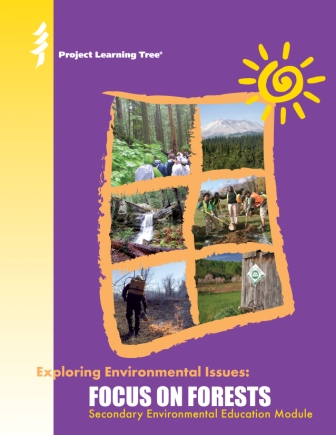
I had been searching for a way to do this; then I came across Project Learning Tree. In my usual teacher mode, I investigated it between classes and late at night. I found an introduction to Activity 1, Monitoring Forest Health in PLT’s high school module Exploring Environmental Issues: Focus on Forests. In this activity, students take measurements to determine the health of a local forest, and evaluate the ecological services provided by trees and forests. My curiosity was piqued.
Working in an Urban Environment
I teach at Holyoke Catholic High School, a newly built small urban school in western Massachusetts. All we have access to are city streets and individual trees to study, no forestland.
After finding PLT’s Student Page “Evaluating Tree Benefits” from Focus on Forests, I successfully used it with students on the trees we were already studying. The students were amazed at how important these small trees were. I posed the question, “If these few trees are important, what about a whole forest?” Now my students were curious.
Making Connections
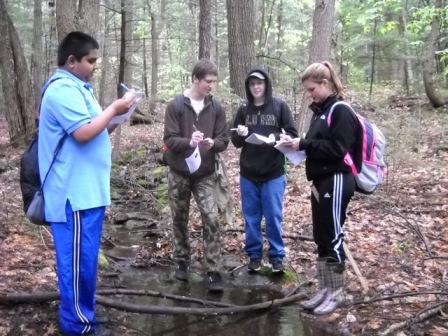 When I began teaching at Holyoke, my students were working on phenological studies using the Harvard Forest Schoolyard Long Term Ecological Research (LTER) Program. In this program, students learn to collect ecological data, share it with other schools and working scientists, and participate in authentic, field-based research projects that address current environmental issues.
When I began teaching at Holyoke, my students were working on phenological studies using the Harvard Forest Schoolyard Long Term Ecological Research (LTER) Program. In this program, students learn to collect ecological data, share it with other schools and working scientists, and participate in authentic, field-based research projects that address current environmental issues.
I quickly realized that the Harvard Forest Schoolyard LTER program was a perfect fit with Project Learning Tree and I asked my PLT State Coordinator if she could host a PLT Focus on Forests professional development workshop in conjunction with Harvard Forest. The combined workshop took place in June 2012. Many educators attended and we each received PLT’s 176-page Exploring Environmental Issues: Focus on Forests activity guide.
As excited as I was, I desperately wanted to find a forest for seventy students to study. I contacted the Appalachian Mountain Club (AMC), a group that cares for the outdoors as much as I, and who are experts at introducing it to young people. Their educational outreach program is called “A Mountain Classroom” and though students usually travel to visit forests in New Hampshire, I asked if AMC would help me implement a three-plot forest study using PLT’s Monitoring Forest Health activity at their small outdoor center nearby. I told them I would commit to a long-term study and provide them with the data we collected.
From the Classroom to the Outdoors
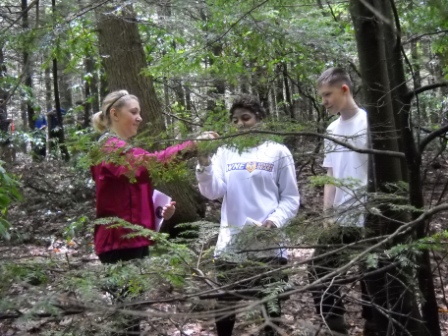 So how did I teach it? We spent two weeks in the class and lab studying content on forests, soils, and water and the connections among them. I introduced forest disturbances to my students using Activity 7, Forest Invaders and Activity 2, Story of Succession from PLT’s Focus on Forests. I used classroom lectures to teach about indicators of forest health, and performed soil porosity labs as well as other activities to emphasize the importance of each indicator.
So how did I teach it? We spent two weeks in the class and lab studying content on forests, soils, and water and the connections among them. I introduced forest disturbances to my students using Activity 7, Forest Invaders and Activity 2, Story of Succession from PLT’s Focus on Forests. I used classroom lectures to teach about indicators of forest health, and performed soil porosity labs as well as other activities to emphasize the importance of each indicator.
After our two-week classroom study, we spent an entire day in the field at our plot sites at the AMC Nobleview Outdoor Center. This is where the collaborative effort finally paid off. The AMC Mountain classroom team met us at our plot site and each staff member led one of six different teams of twelve students. Each team spent four hours collecting data on their plots. We also conducted water quality tests on a nearby stream. We incorporated team building activities and lunch in the woods. It was a great learning opportunity for my students…and it was a lot of fun!
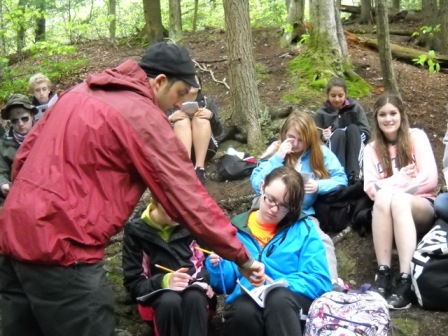 Once we returned to school, we spent three 45-minute periods compiling the groups’ data into a full class dataset and verified our findings. This emphasized the importance for collaboration and communication skills among scientists. Once the final Excel spreadsheet was made in class, I made it available to students online. They could access the file, adjust the format, and make graphs. I gave them one week at home to do the analysis and put a final report together. The final lab report consisted of an introduction, background information on forests, soils, and watersheds, data tables, graphs with results statements, and a final discussion and conclusion. Through this collaboration, classroom study, field survey, and reporting process, my students explored the overall health of the forest.
Once we returned to school, we spent three 45-minute periods compiling the groups’ data into a full class dataset and verified our findings. This emphasized the importance for collaboration and communication skills among scientists. Once the final Excel spreadsheet was made in class, I made it available to students online. They could access the file, adjust the format, and make graphs. I gave them one week at home to do the analysis and put a final report together. The final lab report consisted of an introduction, background information on forests, soils, and watersheds, data tables, graphs with results statements, and a final discussion and conclusion. Through this collaboration, classroom study, field survey, and reporting process, my students explored the overall health of the forest.
This first study established a baseline assessment of the health of the forest. Now, each year following this study, future classes will compare the results of their forest health survey with this baseline data to determine if the forest is in decline or not. In addition, the students are collecting data as part of a citizen science Harvard Forest research project to help forest ecologists in the Northeast monitor the spread of the hemlock woolly adelgid, and investigate forest response to this exotic pest.
Making the Grade
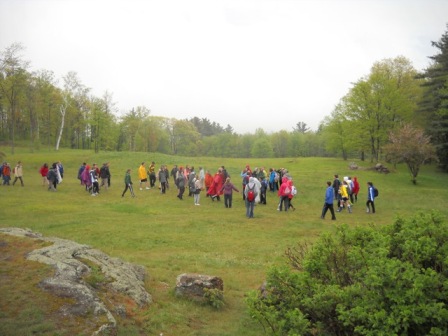 Overall, my class did very well on their reports. Their understanding of trees, forests, and the outdoors improved. To quote one of my students; “. . . I had so much fun in science this year. The field study was really fun, even though that lab report was kind of scary! . . . never, ever, ever stop the way you teach, because even though it’s a lot of work, it’s preparing us for the real life.”
Overall, my class did very well on their reports. Their understanding of trees, forests, and the outdoors improved. To quote one of my students; “. . . I had so much fun in science this year. The field study was really fun, even though that lab report was kind of scary! . . . never, ever, ever stop the way you teach, because even though it’s a lot of work, it’s preparing us for the real life.”
The Harvard Forest program equipped us with the skills to begin ecological research and our collaboration with Project Learning Tree and the Appalachian Mountain Club offered us the opportunity to grow. According to the Next Generation Science Standards this is the type of long-term, investigative, hands-on, and collaborative learning that our students should be engaged in. We are no longer individual students learning in a single classroom, we are all collaborating “scientists,” teachers and children alike working to achieve a higher goal—and learning to love the outdoors.


